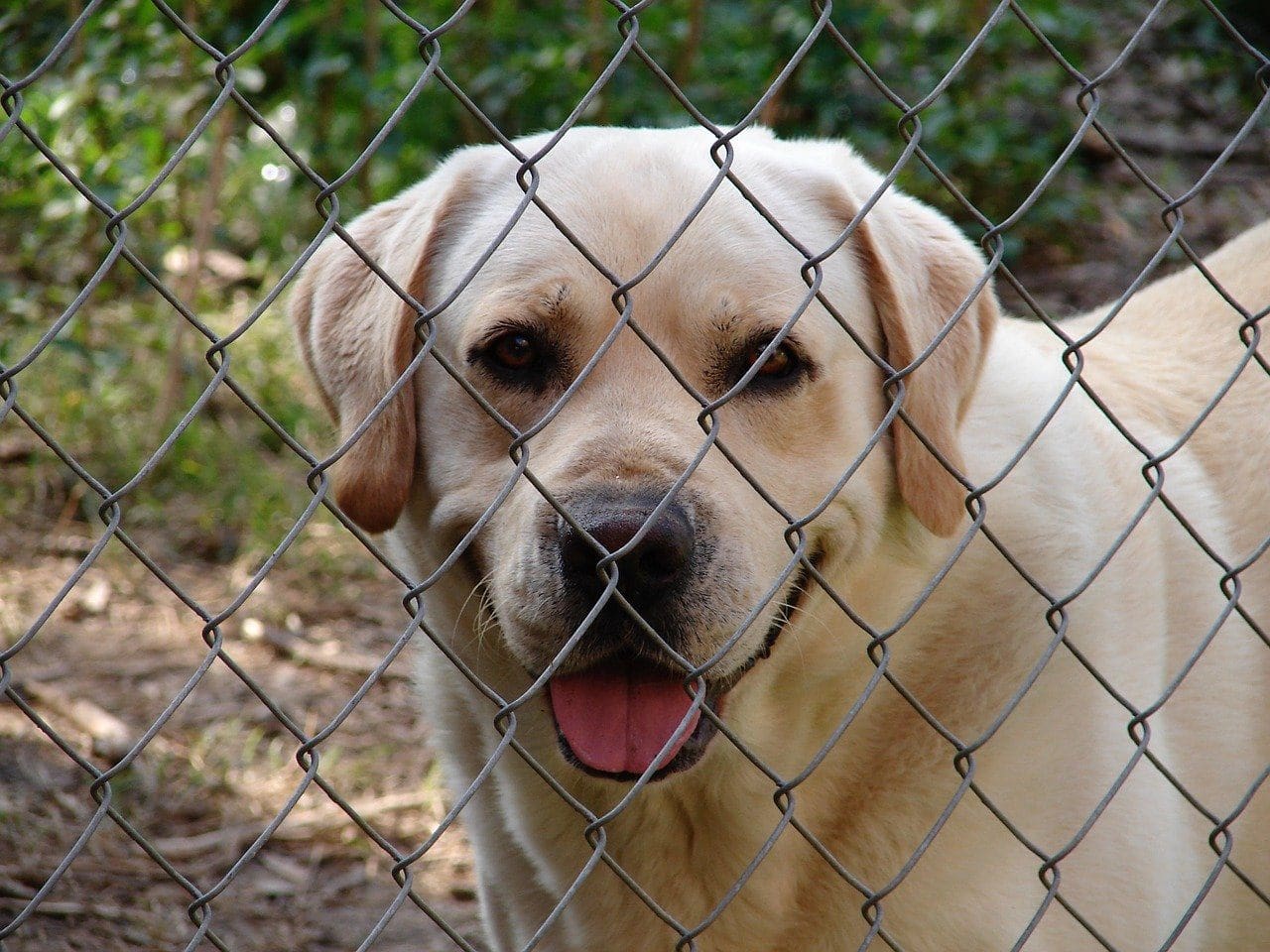If you’re like most dog owners, you want your pup to live the happiest and healthiest life possible. One method of making that happen is ensuring that your dog can run and play outside for exercise and mental stimulation. A great way to offer that freedom is to have a fence installed around your yard.
Before you start planning a fence installation project, though, there are a few things to consider to ensure that you and your pup are happy with the final product.

The 8 Things to Consider When Getting a Fence for Your Dog
1. Your Dog’s Ability to Jump and Climb

It is important to take your dog’s jumping ability into account when deciding what kind of fence to have installed in your yard. If you are unsure of exactly how high your dog can jump, take them to a public agility course or make one in your yard, and put their skills to the test. Throw a ball in the air to see how high they are willing to jump for it. The new fence you decide to invest in should be taller than your pup can jump to keep them from escaping.
You should also be aware of your dog’s climbing abilities. Some dogs work hard to scale a fence that they can’t jump over, as they use a combination of jumping and climbing to get the job done. Chain-link fences are easy to climb, but solid panel fences can help minimize the effectiveness of their climbing.
Your fencing contractor should be able to present you with multiple options for topping your fence with an extra barrier if necessary.
2. Your Dog’s Overall Size
Another thing to think about is your dog’s overall size. If they are large, they likely can’t get through the openings of any fence that you choose to have installed. However, smaller dogs can get through some fences if the openings are large enough. For instance, field fencing has large holes that Chihuahuas and similar-sized dogs could get through.
Even a chain-link fence can be a problem if it gets damaged along the bottom. Wooden fencing with no holes, gaps, or openings is a great choice. Lattice fencing is another affordable option that can hold up well to the shenanigans of small breeds.
3. Your Dog’s Chewing Aggression

Chewing aggression can be a problem when it comes to maintaining your new fence as time goes on. If your pup likes to chew hardily, they could start to break down your fence and threaten the integrity of the unit altogether. They could also injure themselves in the process.
Wooden fencing is attractive to most dogs that like to chew. They will go after any part of the fence that isn’t smooth and may chew on the edges of the boards where they meet one another. Your dog could get splinters in their mouth, which would make it uncomfortable to eat and drink. Aluminum, steel, and chain-link fences are all options to consider for dogs that are aggressive chewers.
4. Yard Privacy and Visibility
You should take the time to consider how much privacy you want to create in your yard and how much visibility to the outside world you want your dog to have before choosing a fence to be installed. A wooden plank fence won’t allow anyone or any dog to see inside or outside of the yard. A chain-link fence will allow both humans and dogs to see through.
There are fencing options in between these, like lattice, which can provide a bit of privacy but still allow your dog to see what’s going on outside of their protected yard. If you still want complete privacy, you could always have a hole cut low in the fence so your dog can catch a glimpse of outside goings-on without exposing themselves or your yard to the oversight of passersby.
5. Gate Security

To determine what kind of gate security you need, you must consider your dog’s personality. Will they try to get out through the gate, or are they content with being in the yard? Will they protect the gates or try to stay away from them? You want gates that will keep your dog inside of your fenced yard while keeping intruders out.
If your dog tries to get out or you are worried about intruders, electronic gates with locks that do not accept typical keys are great options. If you are not concerned about these things, a basic door latch should be enough to keep your pup in the yard. There are many options in between to consider too, so make sure to talk to your fencing contractor about these factors.
6. Maintenance Requirements
Another thing to consider when choosing a fence for your dog is general and long-term maintenance requirements. If you can’t keep up with the maintenance of any specific type of fencing, chances are that it will break down as time goes on, and you may end up without an effective fence.
It is important to make sure you thoroughly understand the maintenance requirements of any type of fencing that you consider investing in. If you can’t manage the maintenance of the fencing that you’re most interested in, find out if your service provider offers a maintenance plan that you can buy to have your fence professionally managed.
7. Existing Barriers

Your yard may already have existing barriers that can be incorporated into your fence line, which can save you money on your overall fencing project. Maybe there is a berm that can be built up to create a natural wall and can be connected to your fence to create a solid and effective barrier.
Your fencing contractor can help you determine which existing barriers, if any, can be incorporated into your fence line. However, don’t expect them to offer this information freely. Most fencing contractors encourage installing as much fencing as possible to maximize their profits.
8. Expansion Possibilities
Take the time to think about whether you may want to expand your fence line in the future for any reason. Maybe you only have the budget to fence a small area of your yard for your dog right now. Or perhaps you will decide to get more pups in the future and have to extend your fencing to accommodate them.
Whatever the case, the easier it is to expand the fencing, the less expensive the project will be. By letting your contractor know about possible plans for expansion in the future, they can create multiple fencing layout options to choose from that will make the expansion job easy and budget-friendly if you ever decide to go ahead with such a project.

Why It’s a Good Idea to Invest in Fencing for Your Dog
There are a few good reasons to consider investing in a new fence for your dog. First, a fence can be extremely convenient when your dog needs to use the bathroom in the middle of the night or when it’s cold, and you don’t want to go outside with them. Just let them into the fenced yard, and they can handle business on their own.
Second, a fence will enable your pup to get outside and exercise safely when you’re too busy or tired to take them on a walk. Third, the fencing will help keep stray dogs and other animals out of your yard. Finally, depending on the type of fence that you get installed, it could provide you with extra privacy while keeping your dog from being able to see every person and car that goes by, so they only bark when necessary.

Conclusion
Getting a fence for your dog is a great way to expand their living space while keeping them safe from the outside world. There are many different kinds of fencing to choose from and multiple layout designs to consider.
Hopefully, the points outlined here will make the process of choosing a new fence to install in your yard easier and less stressful overall.
- Related read: How to Keep a Dog From Jumping & Climbing the Fence
Featured Image Credit: pgbsimon, Pixabay


















